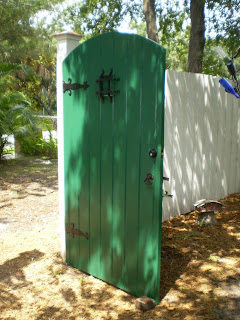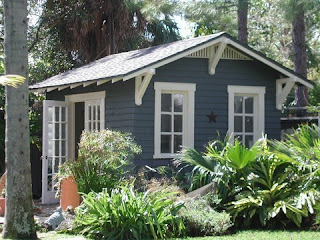We designed what I consider our cutest shed to date (it is pink, after all) for a 1920s jerkinhead Florida bungalow with Craftsman and Tudor influences. The stucco house has a prominent chimney on the front elevation, rounded rafter tails, wonderful arched brackets supporting broad eaves, and decorative cut outriggers on the clipped gable ends. The owners contacted Historic Shed for a series of home improvement projects including building a new fence and custom gate, installing new carriage house style doors on the historic garage, and constructing a new jerkinhead shed.
 |
| With the exception of replacement windows at the sunporch, this romantic bungalow remains largely unaltered with many great architectural details |
 |
| Decorative elements on the main elevation |
The first project we undertook at the bungalow was to relocate the side fence towards the front of the property in order to increase the backyard size. As part of the fence relocation, we installed a custom cypress gate with a speakeasy door with metal grill. The arch of the gate door was designed to reflect the arched front door of the home.
 |
| Arched garden gate |
 |
| Speakeasy door detail |
The historic garage on the property was largely intact, complete with a historic screened addition on one side, but with a 1950s-era metal garage door that looked out of character on the building. Historic Shed built and installed new carriage house type doors made of cypress bead board hung with heave duty strap hinges for a more compatible historic appearance.
 |
| Garage with new carriage house style doors installed |
The new outbuilding project that we constructed at the home was an 8'x10' jerkinhead shed that incorporated design elements from both the main house and historic garage. The owners were exploring ideas to hide the pool pump in the backyard and had considered several options before finding our HistoricShed.com ad in a historic neighborhood newsletter. They decided that our shed styles were the perfect solution for maintaining the historic look of their property, gaining useful space, and hiding the pool pump.
 |
| The yard with pool equipment visible |
While definitions of what constitutes a bungalow home vary, the common ingredients generally include one to one-and-a-half stories, a full or nearly full-width front porch, and a low slope roof. Examples can exhibit a variety of architectural styles including Craftsman, Mission and vernacular. We have designed sheds to complement a variety of bungalow homes, most with Craftsman detailing such as eave brackets and exposed rafter tails.
One of our earliest Historic Shed designs complemented a 1923 Craftsman bungalow within the historic Hyde Park neighborhood in Tampa. The bungalow featured a cross-gable roof with a small front gable vent dormer, a full width integral front porch with brick piers and round spool columns, integral carport, exposed rafter tails and eave brackets. We fully renovated the house, inside and out, including reopening the front porch that had been enclosed with jalousie windows and installing a period-inspired breakfast nook.
 |
| Bungalow "Before" |
 |
| Bungalow "After"
New Breakfast Nook |
As the renovations came to a close, the room that had been designated a home office was reallocated as a nursery for a second child. To replace the lost office space, we built a 10'x14' shed in the rear yard to complement the main house, complete with finished interior, electrical service, internet, cable TV and a wall unit AC. The new shed was designed and built with the same roof slope, gable end vents, exposed rafter tails, eave brackets, siding, etc. as the main house. The interior had wood flooring, beadboard-covered raised ceiling and board and batten interior walls. Because of site constraints, the shed was site-built.
 |
| Framing the home office Historic Shed on site |
 |
| The home office shed nestled into the landscaping |
 |
| The shed is accessed via a bridge over a koi pond and has a reclaimed brick patio - not a bad commute! |

